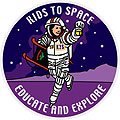29. What raw materials could we mine? (A K2S Question)
From The Space Library
Part of the answer depends on what you're looking for, and partly on where you're looking for it. Some materials are best found in the Mare regions, others in the highlands. Something like hydrogen can only be found in the ever-dark craters at the lunar north and south poles. The first thing everyone considers is oxygen. It's important for breathing, you need it for water, and it can be used as rocket propellant. Some 45 percent of the Moon's surface is oxygen, but chemically bound into minerals. Heat and energy can be used to unbind oxygen from the lunar rocks. Hydrogen is also important, as it's the other component of water, as well as a good rocket fuel. We know there are relatively large amounts of hydrogen at the lunar poles. We hope it's in the form of water, but it could also be things like methane (CH4) deposited by comet impacts— we just don't know right now, although we hope to learn by 2010. Silicas are very useful for things like solar cells, which could be manufactured on the Moon's surface. Over the long term it will be cheaper to do so than to keep making them on Earth and shipping them to the Moon. There are fair amounts of structural metals like iron, aluminum and titanium in the Moon's soil which can be used in various ways. About five percent of the meteoroids we've found on Earth have been metallic and included platinum group or noble metals that are very useful in industry and manufacturing, such as for cell phones. We assume, then, that about five percent of the impacts on the Moon have also been of metallic asteroids, and therefore there are significant amounts of these metals that have been deposited on the Moon's surface over time. The question is how they are distributed as a result of the impact. One of the unusual things that was found in the returned Apollo samples was a rock containing large amounts of potassium (K), rare earth elements, or the Lanthanide series of the Periodic Table, and phosphorous (P), leading the rock type to be named "KREEP." The rare Earth elements are useful in advanced materials sciences. Also found on the Moon were several new types of minerals which had never been seen on Earth, such as armalcolite (after Armstrong, Aldrin and Collins), tranquilityite, which was later identified in South Africa, and pyroxferroite. A total of five such new minerals have been found to date, one just recently. http://aerospacescholars.jsc.nasa.gov/HAS/cirr/em/8/4.cfm (See CDROM)
Answer provided by Thomas Matula, Ph.D. & Kenneth J. Murphy
 Question and Answer extracted from the book Kids to Space - by Lonnie Schorer
Question and Answer extracted from the book Kids to Space - by Lonnie Schorer
Buy This Book Click here |

